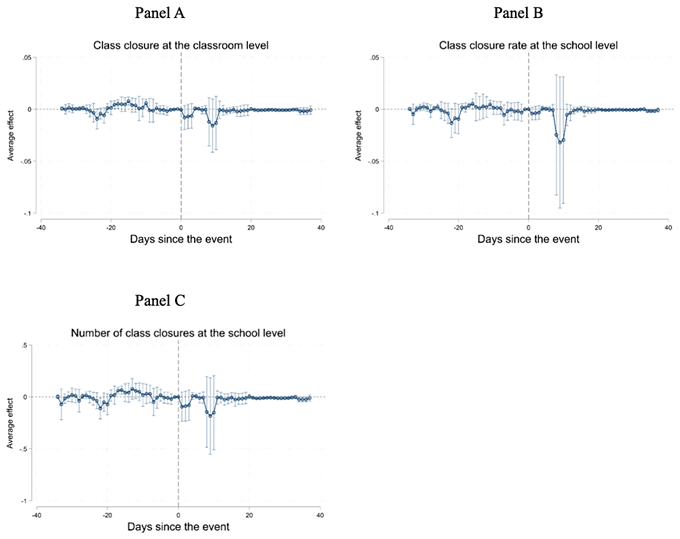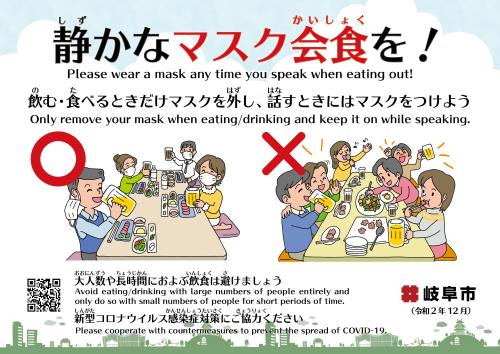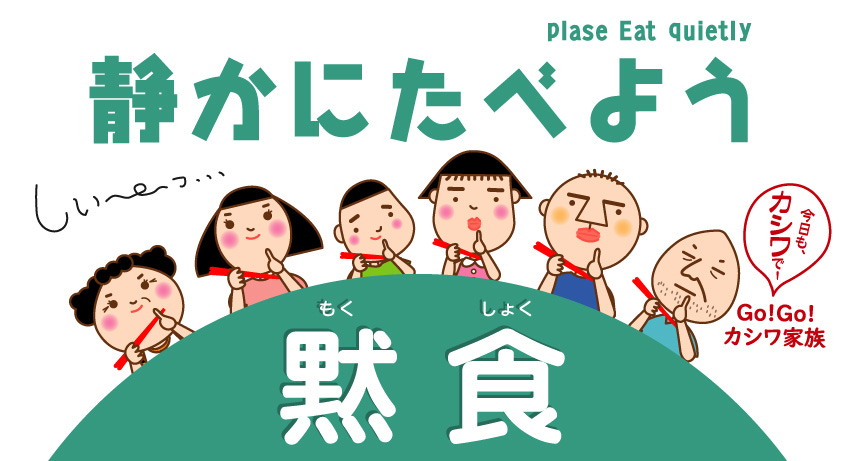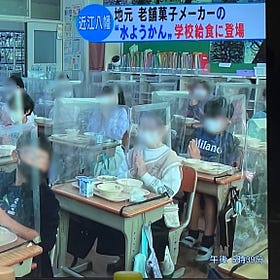What Japan’s Covid response lacked in authoritarian nastiness, it made up for in innovative stupidity. And Japan’s experts clearly put much effort into applying their breathtakingly mediocre intellects to the vexing question of how to “stop the spread” during mealtimes. For adults, their solution was mask dining.
Unless you’ve seen people voluntarily practice mask dining in real life, you have no idea how low your opinion of humanity can go.
The other great contribution Japan made to mealtime non-pharmaceutical interventions (NPIs) was silent eating (黙食, mokushoku).
Fortunately, mask dining and silent eating were never widely adopted in restaurants and bars, showing there were limits to the idiocy that most Japanese adults were willing to go along with. But unfortunately, these limits didn’t extend to the idiocy that Japanese adults were willing to make children go along with, so Japanese school kids were forced to eat in silence for 2.5 to 3 years.
But now, at least 3.5 years too late, the Japanese government think tank Research Institute of Economy, Trade and Industry (RIETI) has released a paper estimating the effects of mokushoku titled “The Effect of Silent Eating during Lunchtime at Schools on the COVID-19 Outbreaks”.
Silent eating—no talking during mealtimes—was used as a measure to reduce the spread of infectious diseases during the COVID-19 pandemic because the emission of droplets during conversations was considered a risk factor for spreading the virus. Japan implemented silent eating during school lunchtimes in February 2020, and it remained in effect until November 2022. However, concerns have been raised regarding the potentially negative effects of the policy on children's well-being and educational attainment. More importantly, no study to date has examined its effectiveness in reducing the risk of COVID-19 outbreaks. This study aims to address this important knowledge gap by examining the impact of silent eating on the risk of COVID-19 outbreaks.
So dear reader, are you as excited as I am that this “important knowledge gap” is finally going to be filled?
In November 2022, the Japanese government announced that silent eating in public schools was no longer needed, triggering some schools to discontinue this measure while other schools continued its implementation.
If I may be slightly pedantic, the national government actually announced that they never requested mokushoku in the first place, as I moaned about at the time.
Silent school lunches: Govt claims it was never their rule
But this is hierarchical and conformist Japan, so rather than angrily demand to know why the government didn’t mention this for 2.5 years, most schools continued mokushoku until March 2023. Anyway, back to the study.
Utilizing this cancelation of the silent eating requirement as a natural experiment, we investigated whether silent eating was associated with a reduced risk of COVID-19 outbreaks. We measured the probability of class closures in public schools (the government’s guidelines required class closures when more than one child in a class was infected with COVID-19) by applying a Difference-in-Differences model with two-way fixed effects to panel data.
Specifically, they looked at data from 11 cities in Chiba Prefecture where 22.3% of schools (45/202) lifted the mokushoku requirement. These schools make up the control group, and the mokushoku schools make up the treatment group. In a Difference-in-Differences model, if a treatment has an effect, the two groups should diverge after an event (here the lifting of mandated mokushoku). So what were the results?
Figure 3 presents the event study figures for the class closures at the classroom level (Panel A), the class closure rate at the school level (Panel B), and the number of class closures at the school level (Panel C). The x-axis shows the days relative to the first day of lifting silent eating in control schools, labeled as day 0.

The 95% confidence intervals cross 0 for the entire period after mokushoku is lifted in the control schools, meaning mokushoku didn’t significantly reduce school or class closures for even a single day.
[W]e did not find strong evidence supporting the notion that silent eating during lunchtime at school would decrease the spread of infection.
Say it ain’t so! Next you’re going to tell me partitions don’t work either.
So what’s the takeaway from the filling of this “important knowledge gap”?
Our findings indicate that policymakers should be cautious about using silent eating at schools as a potential lever to control outbreaks of infectious diseases.
I find it ironic that they advise policymakers to “be cautious” since the zero-risk mentality of the Japanese was a major reason mask wearing, silent eating in schools, chanting bans at sports games, and other semi-superstitious behaviour went on for so long here.
I’ve read more papers about NPIs over the last few years than most people could be forced to do at gunpoint, but I’ve never read a paper that managed to be both so unnecessary and so vital at the same time. It’s unnecessary because of course mokushoku doesn’t work! They might as well say that other things policymakers should be cautious about using as potential levers to control outbreaks of infectious diseases include animal sacrifice, self-flagellation, and female genital mutilation. But it’s vital because in future virus scares, anti-mokushoku parents will now have a study to point to, from a Japanese government think tank no less.
But now they’ve released a study showing that talking while unmasked didn’t make a difference during lunchtimes, it’d be nice if the researchers did a study showing that talking while unmasked didn’t make a difference during the rest of the school day either. But when it comes to the pointlessness of masks, Japanese researchers continue to stay silent.







Guy,
Some excellent observations right off the bat.
“What Japan’s Covid response lacked in authoritarian nastiness, it made up for in innovative stupidity.”
Oh and how!
“Unless you’ve seen people voluntarily practice mask dining in real life, you have no idea how low your opinion of humanity can go.”
A more truthful statement has never been made. Witnessed this again just Saturday as I waited down town for the 10 year old to take his cram school test.
That’s said, it is painful to read this. Parts are universally true and others are or not depending upon geography, employment of other factors. Masking between bites did catch on here in the greater Tokyo area. Well, each time the bars were allowed to reopen. It remains prevalent though not universal.
Mokushok. Arrrrrrrg! After a brief respite at the end of last school year, his school has reinstated the requirement and he is still not allowed to speak during lunch time. Masks have been optional since after GW with more and more students and teachers no longer wearing them. However, as there are many kids in the 3rd grade with either flu of Covid, that grade is once again required to wear them again outside of school they are. At least the ones we have seen out and about town. But I must include this, my train just stopped above a small playground. Looking down at it and the small kids and mothers there, I see not a single mask. This, right Faucing now, at this very moment is the first time I have observed a play ground without a single mask in 3 1/2 years. But as you said, too little, too late.
I am going to print out the study, in Japanese, and send it to my kids’ schools, the city board of education and probably to all my employers, past and present that had or still have this idiotic policy.
Thanks again.
At the start of COVID insanity, we advised the principal at our kindergarten near KIX that we didn’t want our children to wear masks. He ignored the three page letter my wife penned which described our research and conclusions. He said he had studied also and decided, "The children MUST wear masks!"
We made a call to the local health board and they said "While we recommend children wear masks, the school cannot force the children to wear them. Would you like us to call the school for you and advise them of this?" Our answer was "Yes, please!" The result? Our children never wore masks for the entire three years! They were the only ones who were maskless in the entire school.
Sadly, the night after my son's graduation last May, the young and healthy wife of the kindergarten principal went to sleep and never woke up. She died of a heart attack at 44. You can imagine what my opinion is on her cause of death. The principal was not just a proponent of masks, but vaccines and boosters, too. He didn’t bother to get an autopsy done.